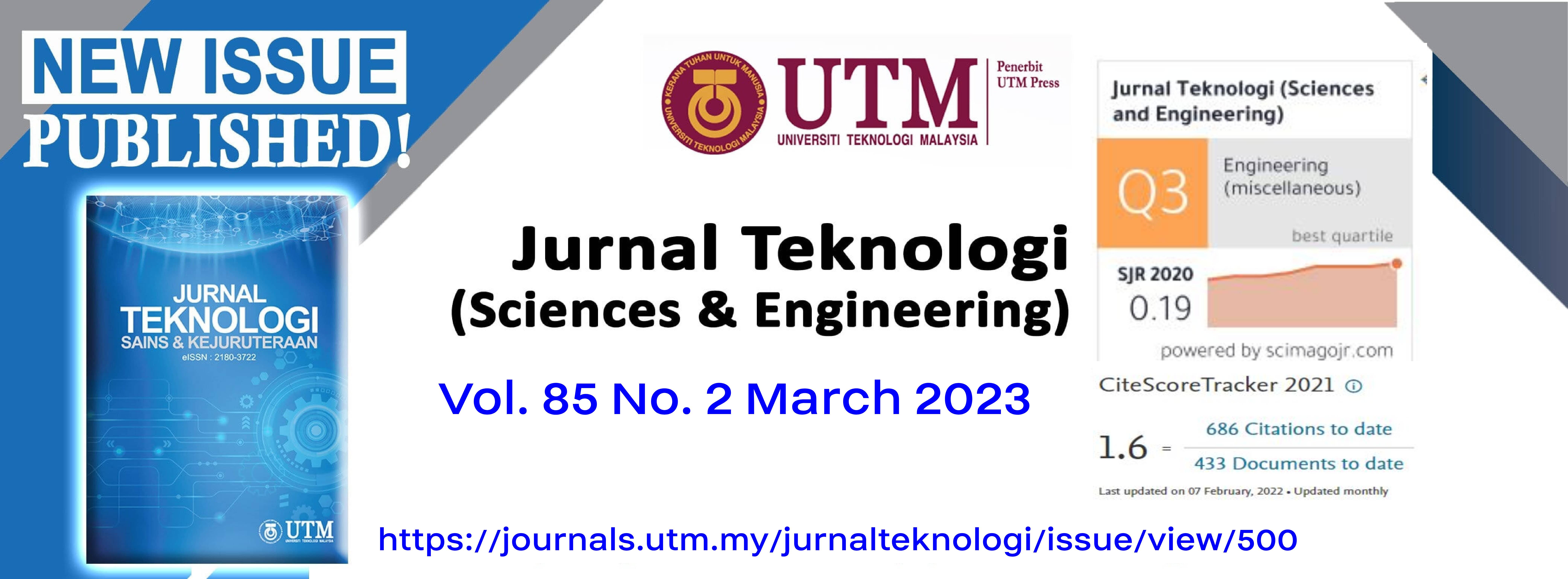GEOMETRICAL FEATURE OF LUNG LESION IDENTIFICATION USING COMPUTED TOMOGRAPHY SCAN IMAGES
DOI:
https://doi.org/10.11113/jurnalteknologi.v85.18828Keywords:
Computed tomography, image processing, image segmentation, lung cancer, lung lesionAbstract
Lung lesion identification is an important aspect of an early lung cancer diagnosis. Early identification of lung cancer may assist physicians in treating patients. This paper uses computed tomography scan images to present a lung lesion identification geometrical feature. From the previous studies, lung segmentation is particularly challenging because differences in pulmonary inflation with an elastic chest wall can result in significant variability in volumes and margins when attempting to automate lung segmentation. Besides, the features used to describe a lung lesion focus on image features which are geometric, appearance, texture, and others. This study develops an image processing technique that uses image segmentation algorithms to segment lung lesions in computed tomography images. The suggested approach includes the following stages, which require image processing techniques: data collection, image segmentation, and performance evaluation. The computed tomography scan images were collected from Advanced Medical and Dental Institute (AMDI), Universiti Sains Malaysia database. As a contribution to biomedical engineering, this study has successfully calculated the performance of the image processing method for lung segmentation, which gets an average accuracy of 99.38%, recall is 99.45%, and F-score is 99.6. The lung lesion segmentation approach based on the object's size could help investigate image abnormality for medical analysis. From the study, 80% of the total lesion identification using the proposed method was correctly predicted when compared with the radiologist's lesion mark. The experiment results found clear support for the next stage of this research.
References
P. Chalasani and S. Rajesh. 2020. Lung CT Image Classification using Deep Neural Networks for Lung Cancer Detection. Int. J. Eng. Adv. Technol. 9(3): 3998-4002. Doi: 10.35940/ijeat.c6409.029320.
S. Bhatia, Y. Sinha, and L. Goel. 2019. Lung Cancer Detection: A Deep Learning Approach. Adv. Intell. Syst. Comput. 817: 699-705. Doi: 10.1007/978-981-13-1595-4_55.
W. D. Travis et al. 2015. The 2015 World Health Organization Classification of Lung Tumors: Impact of Genetic, Clinical and Radiologic Advances since the 2004 Classification. J. Thorac. Oncol. 10(9): 1243-1260. Doi: 10.1097/JTO.0000000000000630.
M. Vas and A. Dessai. 2018. Lung Cancer Detection System using Lung CT Image Processing. 2017 Int. Conf. Comput. Commun. Control Autom. ICCUBEA 2017. 1-5. Doi: 10.1109/ICCUBEA.2017.8463851.
G. Castellano, L. Bonilha, L. M. Li, and F. Cendes. 2004. Texture Analysis of Medical Images. Clinical Radiology. Doi: 10.1016/j.crad.2004.07.008.
H. Shaziya, K. Shyamala, and R. Zaheer. 2018. Automatic Lung Segmentation on Thoracic CT Scans Using U-Net Convolutional Network. Proc. 2018 IEEE Int. Conf. Commun. Signal Process. ICCSP 2018. 643-647. Doi: 10.1109/ICCSP.2018.8524484.
B. H. Heidinger et al. 2017. Lung Adenocarcinoma Manifesting as Pure Ground-Glass Nodules: Correlating CT Size, Volume, Density, and Roundness with Histopathologic Invasion and Size. J. Thorac. Oncol. 12(8): 1288-1298. Doi: 10.1016/j.jtho.2017.05.017.
T. J. N. Hiltermann et al. 2012. Circulating Tumor Cells in Small-cell Lung Cancer: A Predictive and Prognostic Factor. Ann. Oncol. 23(11): 2937-2942. Doi: 10.1093/annonc/mds138.
S. T. Ligthart et al. 2013. Circulating Tumor Cells Count and Morphological Features in Breast, Colorectal and Prostate Cancer. PLoS One. 8(6): 1-11. Doi: 10.1371/journal.pone.0067148.
K. V. Rani and J. J. S. 2018. Emerging Trends in Lung Cancer Detection Scheme-A Review. International Journal of Research and Analytical Reviews. 5(3): 530-542.
S. A. Patil, V. R. Udupi, C. D. Kane, A. I. Wasif, J. V. Desai, and A. N. Jadhav. 2009. Geometrical and Texture Features Estimation of Lung Cancer and TB Images using Chest X-ray Database. 2nd Int. Conf. Biomed. Pharm. Eng. ICBPE 2009 - Conf. Proc. Doi: 10.1109/ICBPE.2009.5384113.
J. Dhalia Sweetlin, H. K. Nehemiah, and A. Kannan. 2018. Computer Aided Diagnosis of Pulmonary Hamartoma from CT Scan Images using Ant Colony Optimization based Feature Selection. Alexandria Eng. J. 57(3): 1557-1567. Doi: 10.1016/j.aej.2017.04.014.
F. Bianconi, I. Palumbo, A. Spanu, S. Nuvoli, M. L. Fravolini, and B. Palumbo. 2020. PET/CT Radiomics in Lung Cancer: An Overview. Appl. Sci. 10(5): 1-11. Doi: 10.3390/app10051718.
K. M. M. Tun and A. S. Khaing. 2014. Feature Extraction and Classification of Lung Cancer Nodule using Image Processing Techniques. Int. J. Eng. Res. Technol. 3(3): 2204-2210.
N. D. 2020. Detection of Lung Cancer using SVM Classifier. Int. J. Emerg. Trends Eng. Res. 85: 21772180. Doi: 10.30534/ijeter/2020/113852020.
M. Z. Alom, M. Hasan, C. Yakopcic, T. M. Taha, and V. K. Asari. 2018. Recurrent Residual Convolutional Neural Network based on U-Net (R2U-Net) for Medical Image Segmentation. arXiv:1802.06955.
Y. F. Riti, H. A. Nugroho, S. Wibirama, B. Windarta, and L. Choridah. 2016. Feature Extraction for Lesion Margin Characteristic Classification from CT Scan Lungs Image. Proceedings - 2016 1st International Conference on Information Technology, Information Systems and Electrical Engineering, ICITISEE 2016. Doi: 10.1109/ICITISEE.2016.7803047.
A. Baratloo, M. Hosseini, A. Negida, and G. El Ashal. 2015. Part 1: Simple Definition and Calculation of Accuracy. Sensitivity and Specificity. 3: 48-49.
Downloads
Published
Issue
Section
License
Copyright of articles that appear in Jurnal Teknologi belongs exclusively to Penerbit Universiti Teknologi Malaysia (Penerbit UTM Press). This copyright covers the rights to reproduce the article, including reprints, electronic reproductions, or any other reproductions of similar nature.
















